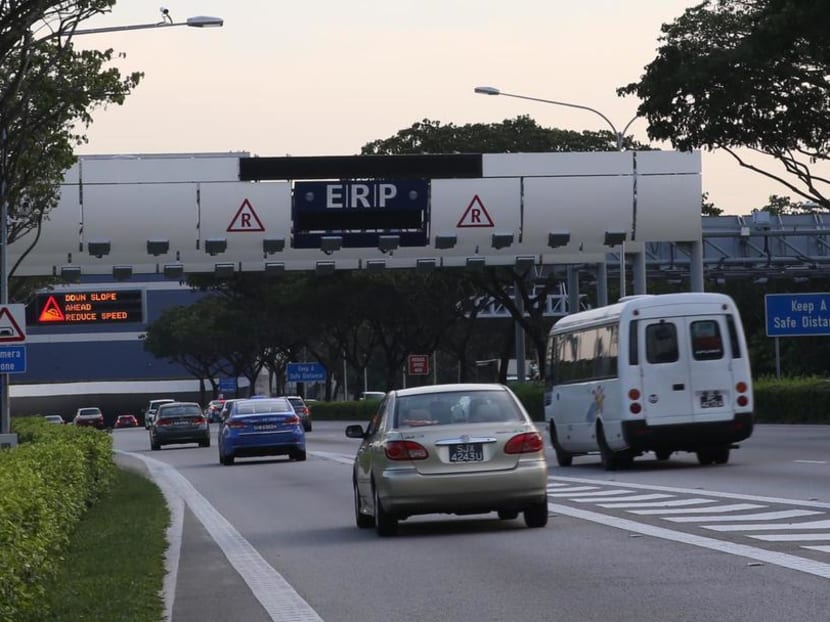Distance-based charging for ERP system a ‘significant change’ that needs further study: Ong Ye Kung
SINGAPORE — The next-generation Electronic Road Pricing (ERP) system is capable of charging motorists according to the distance they travel, but distance-based charging is a major policy that has to be studied closely before it is rolled out, Transport Minister Ong Ye Kung said on Thursday (Sept 10).

Transport Minister Ong Ye Kung said that as the new satellite-based ERP system cuts over in 2023, it is much better to continue congestion pricing in a way that has been effective and motorists are used to, which is gantry- and point-based.
- Distance-based charging is a ‘significant policy change’, Transport Minister Ong Ye Kung said
- The policy has many implications and should be studied carefully, he added
- Deputy Prime Minister Heng Swee Keat had said that its rollout is ‘still several years away’
SINGAPORE — The next-generation Electronic Road Pricing (ERP) system is capable of charging motorists according to the distance they travel, but distance-based charging is a major policy that has to be studied closely before it is rolled out, Transport Minister Ong Ye Kung said on Thursday (Sept 10).
He was explaining in a Facebook post why Singapore will not be adopting a distance-based ERP framework when it switches over to a new satellite-based system in the middle of 2023.
“The system is capable of doing that, but as a policy we are holding back,” Mr Ong said.
“As the system cuts over in 2023, it is much better to continue congestion pricing in a way that has been effective and motorists are used to, (that is) cordon and point-based,” he added.
“Distance-based charging is a significant policy change which has many implications and should be studied carefully.”
Questions on the distance-based charging policy came up after the Land Transport Authority (LTA) announced on Tuesday that the installation of new onboard units (OBUs) to replace the current in-vehicle units (IUs) will start from the second half of next year to facilitate the switch to the new ERP system.
In its statement, LTA said that “while the technology and system have been replaced and upgraded, the way congestion pricing is being levied today will not change”.
When it first announced plans in 2014 to switch to the satellite-based ERP system starting in 2020, LTA had said that this would allow the Government to implement distance-based pricing. It noted that such a framework “as opposed to the current gantry-based system, is more equitable, as motorists will be charged proportionate to the distance travelled on these congested roads”.
However in 2016 and again in June last year, the authorities indicated that there were no plans to immediately revise the road pricing framework once the new satellite-based system is implemented and that there will be a transition period instead.
During the Budget earlier this year, Deputy Prime Minister Heng Swee Keat mentioned that “distance-based charging using ERP is still several years away".
'DON’T UNDERESTIMATE SYSTEM’S COMPLEXIBILITY'
Urban transport management expert Park Byung Joon said that one key issue the authorities may be looking at, in deciding when to roll out distance-based charging, is whether the new system will be able to support the concurrent monitoring of about one million vehicles — which is the car population in Singapore.
“Will there be reliability issues? Will the system crash? And don’t underestimate the system capacity issue. Also, computational complexity goes up exponentially when you are dealing with more and more vehicles at one go. We really shouldn’t underestimate the complexity (of the undertaking),” he said.
The transition to 5G mobile networks — expected to be deployed in Singapore by 2025 — may ease some of these worries, he added.
Another aspect is the pricing policy framework, which could be formulated using big data on the movement of vehicles when identifying congested areas at certain time belts, he said.
“Even though you may be driving the same 10km as other motorists, you shouldn’t be charged the same price on a congested road versus a non-congested road. Or if you are driving at 3am, there is hardly anybody there, so it shouldn’t charge the same price as it would at 8.30am, for example,” he added.
Other concerns that motorists had raised before include whether those who drive for a living and seldom cross ERP zones during peak hours should pay more under the new framework. These drivers may chalk up high mileages heading to relatively inaccessible parts of Singapore.
This, and some other feedback such as why mobile phones can’t replace the IUs, prompted Ms Grace Ong, LTA’s director of transportation technology, to issue a statement in June last year, saying that the authority will “carefully consider all feedback received”.
OTHER QUESTIONS AND ANSWERS
In his Facebook post, Mr Ong addressed such concerns as well, including whether the OBU, which will come with a touchscreen display, will be distracting since most motorists already use their own mobile phone for navigation purposes, and whether they can opt for a unit without a display.
On whether smartphones can be used in place of the OBU, Mr Ong said that this can be a “possible future upgrade”, but it is better to start a new ERP with a standard issue.
“Data security is a key consideration when we decided on a standard issue instead of using our individual smartphones. Further, if we use our own smartphones for ERP, there will be operational issues like battery running out, forgetting to take along smartphones,” he added.
Mr Ong said that the OBU will come with a bigger screen that can display maps, traffic information, as well as safety alerts.
To those who asked if the display unit will be distracting or block the windscreen, Mr Ong noted that “the photos might be a bit misleading”.
He explained that the dimensions of the current IUs are 12.1cm by 7.8cm while the OBUs are “only slightly bigger”, at 15.2cm by 8cm.
“We will be doing consultation with workshops soon, and will discuss how best to install the new units so that it minimises blockage of the windscreen.”
He said that the OBU’s display is a functionality that is “useful to incorporate”.
Other than showing real-time ERP transaction information, LTA can use it to push out other important traffic-related information when there is a need to, he said. “Best to provide it now so that other good uses can be incorporated in the future,” he added.
As for having an OBU without a display, Mr Ong said that there is such a simpler unit available, but motorists would want to know how much is deducted or how much balance is left, so they may ultimately prefer the unit with the screen.
On why there was no public consultation on the OBU’s design, there were “practical constraints”, he said, because LTA had called an international tender for it and became “contractually bound” after choosing the best system to replace the old ERP system.
“There can be consultations and change of design but it will affect the contract. We will have to see how to do this better next time.”








